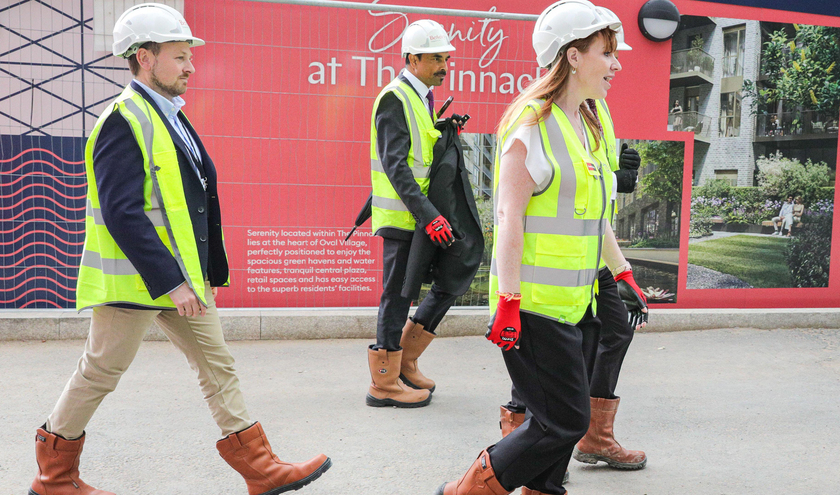With the new Government's plan to build 370,000 homes a year – up from the current expectation of less than 200,000 – there are welcome signs of a gearshift.
The good news is the Labour administration has grabbed housing with both hands in its first 100 days. It has not, yet, pointed to levers other than the private sector to deliver on its ambitions. We will have to wait for the Spending Review on 30 October to see how Angela Rayner's clarion call for ‘the largest expansion of social and affordable housing for a generation' will be delivered.
The enthusiasm of policy alignment and encouragement to the sector needs to be met with a pragmatic response to the realities of delivering in a fragmented housing market. History shows that, while private sector affordable housing derived through section 106 is an important source of homes it is not, on its own, enough to drive the huge increase we need.
Analysts have suggested we have a 4.5 million home shortfall, with 90,000 social rented homes each year needed to rebalance supply. While we might argue numbers housing supply is now a key infrastructure challenge for the UK and it will need several decades of focus to restore balance in the market.
When Mark Farmer and I wrote our paper Build Homes Build Jobs Build Innovation in 2020, we saw the need for housing to be part of a green industrial strategy.
In addressing Covid and Brexit related supply shifts and falling sector capacity to deliver, our report noted the urgency of creating a multiplier effect in the post-pandemic economy.
We also argued that any measures taken needed to flow both into the construction supply chain and, in turn, the wider market in the way that supports economic recovery as well as the UK target to reach a net zero carbon economy by 2050.
Our research showed that there was potential to build 75,000 additional high-quality manufactured homes a year by 2030 creating 50,000 productivity and quality jobs from SMEs to larger companies. Importantly, these jobs could be located in regions where they were needed most.
This thinking is as relevant to today's challenges as it was back then.
We could see that traditional tenures and construction could deliver some increases in a beneficial market, but without a major investment in social and affordable housing, combined with the creation of additional rental supply, the ability of a market to sustain high levels of absorption that drive delivery would struggle to meet the numbers required.
What is also clear is that since 2020, capacity in the construction sector has diminished further and consolidation, together with business failure, has driven out several routes to delivering construction traditionally.
Despite this, it has been astonishing to see the failure rate in the modern methods of construction (MMC) sector.
As we pointed out in 2020, manufacturers need clear future demand for their products that is sustained over many years and many projects. This is also a key ingredient for driving efficiency and productivity to lift housing delivery to that 370,000 number by 2030.
The need to redress the balance in housing would indicate at least a 20-year program requiring a major and sustained increase in capacity, and MMC, for the long term.
To achieve, there will need to be some key additional reforms and policy drivers to support the impressive energy placed into planning reform and traditional housing delivery.
Firstly, consideration regarding ways of aggregating demand suitable for MMC delivery. Clearly the first port of call for this is in the public sector and to align with any uplift in social and affordable housing. The increasing importance of the mayoralties in galvanising delivery within regions could be a real catalyst in establishing commonality across authorities.
Secondly, it is time to pick up on some of the positive themes from past approaches that insist on a measurable outcome-based approach to procuring housing. Procurement has for many years been under the spotlight for driving short-term cost-based approaches to delivery. This tends to be focused on capital expenditure without due regard to operational costs over the life of the building, important for those that hold stock for rent over the long term.
Third. To drive efficiency and productivity, we need continuity of collaboration to lessons are learned and approaches are honed. This is not just for the MMC sector, where continuous improvement is a byword for productivity, but in the wider sector. This includes the whole supply chain from design to delivery. We must move away from site-by-site procurement towards something that enables long-term relationships and rewards the driving of efficiency.
On top of that, social housing funds could come with an expectation that the receiving parties will not continually be reinventing the wheel on a project-by-project basis and that elements of standardisation and best practice, including in MMC, are shared between public sector organisations and contractors and used in design and delivery.
And finally, there should be greater innovation in affordable rental models aimed at the space between social and market rent. For example, the potential of flex rent, linked to household income and aimed at mid-market tenants could add a huge new source of investor friendly homes to the current tenure stack.
It feels like we are about to enter the most positive and proactive political stewardship of housing delivery for a generation. A return to business-as-usual feels inappropriate to both the opportunity and the challenge and we should use the next few months to clearly plan how we can make the most of a government that has clearly set out its stall, with a significant mandate to get some homes built.
Mike De'Ath is a partner at HTA Design LLP mike.de-ath@hta.co.uk
Build Homes Build Jobs Build Innovation – www.hta.co.uk/publications-post/build-homes-build-jobs-build-innovation/



